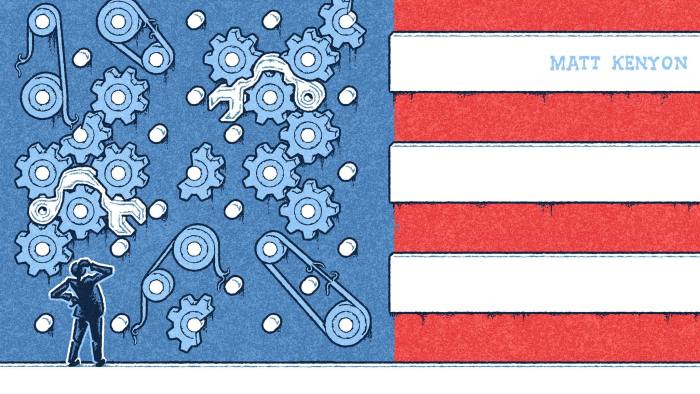Here’s a statistic that tells you much of what you need to know about the US trade debate — only 1 per cent of US companies export. It’s a figure that I uncovered recently in a McKinsey Global Institute report on the state of US manufacturing, which confirmed much of what my own reporting has informed me about US trade problems.
有个统计数字可以在很大程度上揭示美国贸易辩论的概况:只有1%的美国公司对外出口产品。我最近在麦肯锡全球研究所(McKinsey Global Institute)一份有关美国制造业状况的报告中看到了这个数字,它在很大程度上印证了我在撰写美国贸易问题相关报道时得到的感想。
They begin at home, not abroad. That is not a line you will hear over the next few days, as negotiators meet in Mexico for the latest round of North American Free Trade Agreement talks.
美国贸易问题发端于国内,而不是国外。近日有关谈判代表们在墨西哥出席最新一轮北美自贸协定(Nafta)谈判时,你绝不会听到诸如此类的话语。
The Trump administration is likely to point fingers and threaten again to pull out of the whole agreement. But if the White House wants to fix trade, it would do better to look at three crucial mistakes that have been made at home — and then compare them with opposite strategies in China, the world’s biggest manufacturing country.
特朗普(Trump)政府可能对别人横加指责,再次威胁要彻底退出北美自贸协定。但是,如果白宫想解决贸易问题,最好看看本国所犯的三个重大错误,再拿来和世界最大制造业国家中国所采取的相反战略对比一下。
The first mistake was to starve manufacturing of investment. Private sector investment in the sector in the US is at 30-year lows; the ages of the average factory and piece of machinery are 25 and nine years, respectively. The McKinsey Global Institute report estimates that about $115bn of investment would be required annually over the next decade to fix this problem.
第一个错误是让制造业得不到投资。美国制造业的私营部门投资正处于30年低点;工厂和机械平均已投入使用25年和9年。麦肯锡全球研究所的报告估计,要解决这个问题,未来十年每年将需要投资约1150亿美元。
But trade and tax policy in the US does almost nothing to provide an incentive for that investment. Companies talk a good game about repatriation, but privately admit that the bulk of any money brought home will go into share buybacks and dividend payments. Gary Cohn, President Donald Trump’s economic adviser, last week appeared surprised (or perhaps feigned surprise) as three hands went up when, at a conference, chief executives were asked how many would invest at home if tax reform were passed. Why should they, when there are no quid pro quos of repatriation in exchange for equipment investment, training or the funding of an infrastructure bank?
然而,美国的贸易和税收政策几乎完全不能为此类投资提供激励。企业嘴上大谈将海外资金汇回国内,私底下却承认,大部分汇回资金将用于回购股票和派发股息。在近日一次会议上,当首席执行官们被问到假如税改通过有多少人会在国内投资,只有三个人举手,当时唐纳德?特朗普总统(Donald Trump)的经济顾问加里?科恩(Gary Cohn)显得很惊讶(也许只是假装惊讶)。当汇回资金用于设备投资、培训人员和向基础设施银行注资却不能获得补偿时,谁会投资呢?
As the past two decades have shown, supply side economics alone does not result in a productive use of capital, particularly when it comes to global multinationals; sometimes, you have to push investment to the areas where it is needed. That’s exactly what China is doing with its $1tn infrastructure investment plan.
过去20年的情形已经证明,单纯靠供给侧经济学手段并不能促成资本的有效使用,尤其是涉及到全球性跨国企业的时候;有时候,你必须推动投资流入需要资金的领域。这正是中国的1万亿美元基础设施投资计划所做的事情。
Second, the US trade debate has focused far too much on the largest domestic companies, which are doing quite well, in terms of share price, profit margins and sales growth. Yet the vast majority of the 250,000 manufacturing groups in the US employ fewer than 100 people.
第二,美国贸易辩论过多地关注国内大公司,这些公司在股价、利润率和销售增长方面都很出色。然而全美25万家制造业公司中,绝大多数公司的雇员在100人以下。
The current zero-sum game global trade debate hardly applies to them at all. Most do not export, not because they cannot but because access to capital has been tighter for them relative to their rich country peers since the Great Recession (that lack of investment creates a 40 per cent productivity gap between small and large businesses). Reconnecting the dots between the largest exporters and the supply chain could fix that.
当前零和游戏式的全球贸易辩论对它们根本不适用。它们大多数并不出口产品,并非因为它们做不到,而是因为,自大衰退(Great Recession)以来,相对于财力雄厚的国内同行,它们获得资金的渠道收紧得更厉害(投资不足造成了小公司和大公司之间的生产率差距达到40%)。把大型出口商和供应链之间的点重新连接起来,可能会解决这一问题。
Regionalisation is the new globalisation — the largest firms in the US should be given explicit government incentives to work with local suppliers, which would do much to address the president’s trade deficit obsession, since 70-80 per cent of the value of a finished product is in the supply chain.
地区化是新的全球化——美国政府应为国内大公司提供明确激励措施,推动它们与当地供应商合作,这对于解决总统一直纠结的贸易逆差问题大有裨益,因为一件制成品的价值有70%至80%来自供应链。
Again, this is something that China has prioritised in its 2025 development plan, which states explicitly that the country wants to minimise dependence on foreign markets and technologies.
这同样是中国2025发展规划中列为重点的内容。该规划明确指出,中国要把对外国市场和技术的依赖降到最低程度。
Finally, the US desperately needs to connect Silicon Valley and the rust belt. High-tech manufacturing — 3D printing, the internet of things, sensors in products that create business opportunities in data analytics and services, rather than just goods — may well be the future. Yet, shockingly, roughly half of US manufacturing companies have no digital strategy whatsoever, according to an MGI survey.
最后,美国迫切需要把硅谷和“锈带”连接起来。高科技制造业——3D打印、物联网、应用于可在数据分析领域创造商业机遇的产品中的传感器,以及服务,而不仅仅是商品——很可能是未来发展方向。但令人震惊的是,麦肯锡全球研究所的一份调查报告显示,大约一半的美国制造业公司没有制定任何数字战略。
Meanwhile, the technocrats in the Chinese Communist party are giving speeches about the integration of the physical and digital worlds that would leave many people in US boardrooms scratching their heads.
与此同时,中国共产党的技术官员们纷纷发表关于实体和数字世界相融合的演讲,这种讲话内容会让美国企业董事会的许多人摸不着头脑。
Of course, it’s easier to do economic-dot connecting in an autocracy. No one is arguing for that, but it does speak to the core problem — the Trump administration is trying to push “America First” without any clear and coherent plan of what that means, or how to make an industrial strategy happen.
当然,要将经济中的点连接起来,在一个专制体制中会更容易做到。没人提倡这种体制,但它确实揭示一个核心问题——特朗普政府正在努力推动“美国优先”政策,却没有制定明确而连贯的计划来阐明这一政策的含义或者解释如何成功实施一项产业政策。
“You look at the current trade debate and you just think, ‘What a lost opportunity’,” says MGI director James Manyika.
“看着当前的贸易辩论,你只会想,‘我们错失了一个怎样的机会啊’,”麦肯锡全球研究所所长詹姆斯?马尼卡(James Manyika)说。

The countries that the US left behind when the administration pulled out of the Trans-Pacific Partnership — high-growth emerging market nations with expanding middle classes that are engaged in major infrastructure building works — are exactly those with the largest demand for the US’s most valuable exports, such as high-tech products, pharmaceuticals and heavy machinery.
美国政府退出《跨太平洋伙伴关系协定》(TPP)时抛在身后的那些国家——高速增长的拥有不断壮大的中产阶层的新兴市场国家,它们正在参与一些重大的基础设施建设工程——恰恰是对美国最有价值的出口产品(比如高科技产品、药品和重型机械)需求最大的国家。
Pulling out of Nafta, particularly without any kind of homegrown industrial policy, would be an equally big mistake. Economic nationalism with no economic plan will not make America great again. In fact, it may be worse than the laissez-faire alternative.
退出北美自贸协定——尤其是在缺乏任何一种形式的本土产业政策的情况下——将是同等严重的错误。没有经济计划的经济民族主义将不会让美国再次变得伟大。事实上,这也许比自由放任的政策还要糟糕得多。












